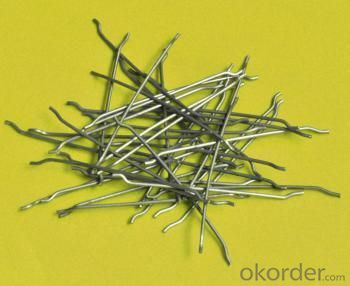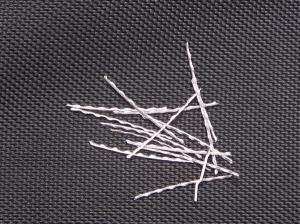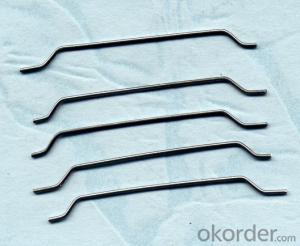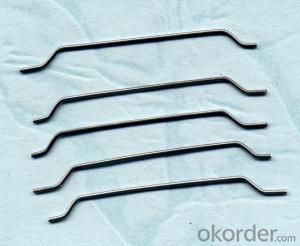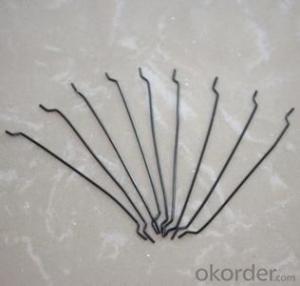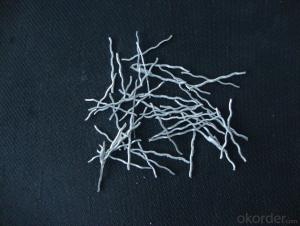Melt Extract Stainless Steel Fiber Reinforced Bending CNBM China
- Loading Port:
- Tianjin
- Payment Terms:
- TT OR LC
- Min Order Qty:
- 1000 kg
- Supply Capability:
- 250000 kg/month
OKorder Service Pledge
OKorder Financial Service
You Might Also Like
Quick Details
Dimensions: steel wire
Grade: steel wire
Application: for concrete reinorcement
Shape: clear and bright
material: steel wire
type: wavy steel fiber
shape: corrugated flat fiber
usage: concrete reinforcement
appearance: clear and bright
Place of Origin: Shandong, China (Mainland)
Product features
steel fiber are for concrete construction, greatly improves concrete bonding and tensile strength .
concrete steel fiber is specially designed to enhance concrete in it`s hardened state ,the uniform distribution of steel fibers throughout the concrete greatly improves concrete bonding and tensile strength ,additionally it provides exceptional load stability and durability .
as reliable and efficient concrete reinforcement material ,it is widely uesd in buildings ,bridges ,thin roof engineering ,highway etc.
Specifications
Diameter :0.5-1.2mm
Tensile strength :≥1100Mpa
Length :20-60mm
properties :excellent tensile ,high tenacity ,against cracking and fatigue
type :any type we can produce according to your request
Picture
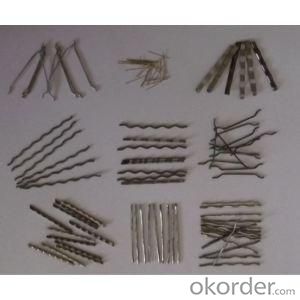
steel fiber concrete reinforced
FAQ
we can produce any type steel fiber and of course we can make production according to your requirement
we have specilize in this field for almost 10 years ,with good quality and competitive price
- Q: How does melt extract stainless steel fiber contribute to the crack control of concrete?
- Melt extract stainless steel fiber plays a crucial role in enhancing the crack control of concrete. These fibers are added to the concrete mixture, where they act as reinforcement to improve the overall strength and durability of the concrete structure. When concrete undergoes shrinkage due to drying or temperature changes, it tends to crack. However, the addition of melt extract stainless steel fibers helps to reduce the width and propagation of these cracks. The unique properties of stainless steel fibers, such as high tensile strength, corrosion resistance, and excellent bonding with concrete, contribute to crack control. These fibers form a three-dimensional network within the concrete matrix, effectively bridging the cracks and restraining their growth. Moreover, melt extract stainless steel fibers also improve the overall ductility and toughness of concrete. This means that even if cracks do occur, they are less likely to propagate and lead to significant structural damage. The fibers act as reinforcement, enhancing the concrete's ability to resist the forces that cause cracking. In addition to crack control, melt extract stainless steel fibers also enhance the overall performance of concrete by providing improved resistance to impact, fatigue, and abrasion. This makes them particularly beneficial in high-stress applications such as industrial flooring, tunnel linings, and precast concrete elements. Overall, the addition of melt extract stainless steel fibers to concrete significantly contributes to crack control by reducing crack width, preventing crack propagation, and improving the overall strength and durability of the concrete structure.
- Q: How does melt extract stainless steel fiber improve the impact resistance of concrete pavers?
- Melt extract stainless steel fiber improves the impact resistance of concrete pavers by reinforcing the concrete matrix. The fibers are evenly distributed throughout the concrete mixture, creating a three-dimensional network that enhances the overall structural integrity of the pavers. This reinforcement helps to absorb and distribute the impact energy, making the pavers more resistant to cracking, spalling, and other forms of damage caused by impact or heavy loads.
- Q: Can melt extract stainless steel fiber be used in pre-stressed or post-tensioned concrete?
- Yes, melt extract stainless steel fiber can be used in pre-stressed or post-tensioned concrete. The addition of stainless steel fibers in concrete can enhance its tensile strength and crack resistance, making it suitable for applications such as pre-stressed or post-tensioned concrete. The unique properties of stainless steel fibers, such as high tensile strength, corrosion resistance, and durability, make them an ideal reinforcement material for concrete structures that are subjected to high loads or potential cracking. Additionally, the melt extract stainless steel fibers can be easily mixed into the concrete mixture and distribute evenly throughout the structure, ensuring uniform reinforcement. Therefore, melt extract stainless steel fibers are a viable option for reinforcing pre-stressed or post-tensioned concrete.
- Q: What is the effect of melt extract stainless steel fiber on the workability of shotcrete?
- The use of melt extract stainless steel fiber in shotcrete can have a significant effect on its workability. Melt extract stainless steel fibers are typically added to shotcrete mixes to enhance its mechanical properties, such as tensile strength, toughness, and durability. One of the main effects of melt extract stainless steel fiber on shotcrete workability is the improvement in cohesion and resistance to segregation. The fibers act as a reinforcement within the shotcrete matrix, effectively increasing its viscosity and preventing the settlement of aggregate particles. This leads to a more homogeneous mixture that is easier to handle and apply. Additionally, the addition of melt extract stainless steel fibers can enhance the overall consistency and pumpability of shotcrete. The fibers act as a lubricant, reducing friction between particles and allowing for smoother pumping and spraying. This results in improved workability, as the shotcrete can be more easily maneuvered into complex shapes and confined spaces. Moreover, melt extract stainless steel fibers can improve the bond strength between shotcrete and substrate. The fibers create a mechanical interlock with the substrate, increasing the adhesion and preventing delamination. This not only enhances the workability during application but also improves the long-term durability and performance of the shotcrete. It is important to note that the effect of melt extract stainless steel fiber on shotcrete workability may vary depending on factors such as fiber dosage, length, aspect ratio, and mix design. Therefore, it is crucial to carefully consider the specific project requirements and consult with experienced professionals to determine the optimal fiber dosage and mix proportions for the desired workability and performance.
- Q: Can melt extract stainless steel fiber be used in architectural concrete applications?
- Certainly, architectural concrete applications can utilize melt extract stainless steel fiber. These fibers, extracted by melting, possess remarkable tensile strength and corrosion resistance, making them highly effective in reinforcing architectural concrete. Not only do they enhance the structural integrity of the concrete and provide added safeguard against environmental factors and heavy loads, but they also contribute to its strength, durability, and crack resistance. Furthermore, the inclusion of stainless steel fibers can greatly improve the final product's aesthetic appeal, as they can be effortlessly polished to achieve a sleek and lustrous surface. In summary, melt extract stainless steel fibers are an ideal choice for architectural concrete applications, offering both functional and visual advantages.
- Q: Can melt extract stainless steel fiber be used in high-rise or tall buildings?
- Indeed, melt extract stainless steel fiber holds applicability in high-rise or tall buildings. Renowned for its robustness and enduring nature, this particular fiber proves fitting for constructions necessitating an elevated degree of structural soundness. Moreover, stainless steel fibers exhibit exceptional resistance to corrosion, fire, and extreme temperatures, all of which represent vital considerations when erecting towering edifices. By incorporating melt extract stainless steel fiber, the overall fortitude and steadiness of the building can be augmented, guaranteeing both its structural integrity and safety.
- Q: How does melt extract stainless steel fiber affect the curing time of concrete?
- Melt extract stainless steel fiber can have both positive and negative effects on the curing time of concrete. The addition of stainless steel fibers can enhance the early age strength development of concrete, leading to a faster curing time. This is because the fibers act as reinforcement, improving the overall mechanical properties of the concrete and reducing drying shrinkage. Furthermore, stainless steel fibers can also improve the durability and crack resistance of concrete, which can result in a faster curing process. By preventing cracks and reducing the need for repairs or maintenance, the concrete can cure more efficiently. On the other hand, the addition of stainless steel fibers can also extend the curing time of concrete. This is due to the fact that the fibers may hinder the movement of water within the concrete mixture, slowing down the hydration process. Furthermore, the presence of fibers can increase the viscosity of the concrete, making it more difficult for moisture to penetrate and fully hydrate the cement particles. Ultimately, the impact of melt extract stainless steel fiber on the curing time of concrete depends on various factors such as the fiber content, aspect ratio, and mix design. It is important to carefully consider these factors and conduct proper testing to determine the optimal dosage and fiber type for achieving the desired curing time in concrete applications.
- Q: How does melt extract stainless steel fiber affect the permeability of concrete?
- The permeability of concrete is significantly affected by the inclusion of melt extract stainless steel fibers. These fibers, which are slender and elongated strands, are incorporated into concrete mixtures during the mixing process. Once evenly distributed throughout the concrete, they form a three-dimensional network that enhances the overall strength and durability of the material. One of the primary advantages of using stainless steel fibers is the reduction in concrete permeability. Concrete is naturally a porous substance, allowing the passage of liquids and gases. However, the addition of stainless steel fibers helps to seal these pores and decrease the permeability of the concrete. The melt extract stainless steel fibers serve as a physical barrier, preventing the infiltration of water, chemicals, and other harmful substances into the concrete. This is particularly crucial in environments where the concrete is exposed to harsh conditions, such as marine or industrial settings. By reducing the permeability of concrete, the inclusion of stainless steel fibers also enhances its resistance to corrosion and deterioration. These fibers help to limit the penetration of moisture and aggressive agents that can cause the reinforcement steel within the concrete to rust. Consequently, the lifespan of the concrete structure is prolonged, and maintenance expenses are minimized. Moreover, the decreased permeability of concrete with stainless steel fibers also improves its ability to withstand freeze-thaw cycles. When water enters the concrete and freezes, it expands, generating internal pressure and leading to cracks and deterioration. The presence of stainless steel fibers restricts the entry of water, thus reducing the potential for freeze-thaw damage. In conclusion, melt extract stainless steel fibers have a positive impact on the permeability of concrete. They diminish the flow of water and other harmful substances, improving the durability, resistance to corrosion, and ability to withstand freeze-thaw cycles of the concrete. By enhancing these properties, stainless steel fibers contribute to the overall performance and longevity of concrete structures.
- Q: How does melt extract stainless steel fiber improve the fire resistance of concrete?
- The fire resistance of concrete is improved by the presence of melt extract stainless steel fiber, which serves as a reinforcement material. When exposed to high temperatures during a fire, the stainless steel fiber reinforces the concrete, enhancing its structural integrity by providing extra strength and stability. The stainless steel fiber is capable of withstanding high temperatures without melting or losing its mechanical properties. As a result, it effectively distributes stress and load within the concrete, preventing cracks and fractures that could compromise the material's structural integrity. Moreover, the stainless steel fiber in the concrete helps delay the occurrence of spalling. Spalling is when the surface layers of concrete break apart and detach due to the rapid expansion of trapped moisture within the material when exposed to high temperatures. By reinforcing the concrete, the stainless steel fiber retains moisture and hinders its rapid release, thereby reducing the risk of spalling. Additionally, the stainless steel fiber acts as a heat sink, absorbing and dissipating heat more efficiently than the surrounding concrete. This capability aids in reducing the overall temperature increase of the material during a fire. By diminishing the temperature rise, the stainless steel fiber can minimize thermal expansion and contraction, decreasing the chances of cracks and preserving the concrete's structural integrity. In conclusion, incorporating melt extract stainless steel fiber into concrete greatly enhances its fire resistance by bolstering its structural strength, reducing spalling, and minimizing temperature rise. This makes it a highly effective solution for enhancing the fire safety of concrete structures in various applications, such as buildings, tunnels, and industrial facilities.
- Q: Can melt extract stainless steel fiber be used in underground construction applications?
- Yes, melt extract stainless steel fiber can be used in underground construction applications. It is a durable and corrosion-resistant material that can enhance the strength and durability of concrete or other construction materials used in underground structures such as tunnels or underground parking garages.
Send your message to us
Melt Extract Stainless Steel Fiber Reinforced Bending CNBM China
- Loading Port:
- Tianjin
- Payment Terms:
- TT OR LC
- Min Order Qty:
- 1000 kg
- Supply Capability:
- 250000 kg/month
OKorder Service Pledge
OKorder Financial Service
Similar products
Hot products
Hot Searches
Related keywords


